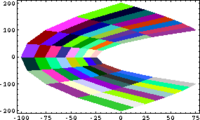0708-1300/Class notes for Tuesday, September 11
From Drorbn
Jump to navigationJump to search
| ||||||||||||||||||||||||||||||||||||||||||||||||||||||||||||||||||||||||||||||||||||||||||||||||||||||||||||
In Small Scales, Everything's Linear

|

| |
Code in Mathematica:
QuiltPlot[{f_,g_}, {x_, xmin_, xmax_, nx_}, {y_, ymin_, ymax_, ny_}] :=
Module[
{dx, dy, grid, ix, iy},
SeedRandom[1];
dx=(xmax-xmin)/nx;
dy=(ymax-ymin)/ny;
grid = Table[
{x -> xmin+ix*dx, y -> ymin+iy*dy},
{ix, 0, nx}, {iy, 0, ny}
];
grid = Map[({f, g} /. #)&, grid, {2}];
Show[
Graphics[Table[
{
RGBColor[Random[], Random[], Random[]],
Polygon[{
grid[[ix, iy]],
grid[[ix+1, iy]],
grid[[ix+1, iy+1]],
grid[[ix, iy+1]]
}]
},
{ix, nx}, {iy, ny}
]],
Frame -> True
]
]
QuiltPlot[{x, y}, {x, -10, 10, 8}, {y, 5, 10, 8}]
QuiltPlot[{x^2-y^2, 2*x*y}, {x, -10, 10, 8}, {y, 5, 10, 8}]
See also 06-240/Linear Algebra - Why We Care.
Class Notes
Let and be two normed finite dimensional vector spaces and let be a function defined on a neighborhood of the point
Def: We say that is differentiable (diffable) if there is a linear map so that Failed to parse (syntax error): {\displaystyle \lim_{h\rightarrow0}\frac{\right\|f(x+h)-f(x)-L(h)\left\|}{\right\|h\left\|}}










